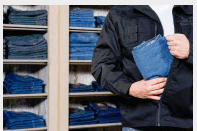Some of the advice security and loss prevention personnel give to retailers and small businesses is that greeting a customer and asking if they need help, are some of the easiest and cheapest methods to prevent shoplifting in their stores. Having a clean, well lit store is helpful and can help employees keep track of customers entering and leaving the premises. If your store is dealing with shoplifting cases in a regular basis, invest in having security cameras installed, anti-theft tags on the merchandise, or anti-theft devices at the entrances. Preventing shoplifting is a necessity that most retailers have to take seriously, and take adequate measures to mitigate their loses.
For more about this and other stories, follow the links below.
Juneau police give retailers tips on stopping shoplifters
“Greet your customer.”
That’s the most important piece of advice Juneau police Officer Ken Colon wanted his audience to remember at the end of his presentation on Friday. He was meeting with nearly 20 people in the backroom of Alaskan Dames, a consignment shop in the Mendenhall Valley.
“Shoplifters, they do not like being greeted. It hinders their ability, it takes away the opportunity and it reduces the desire to commit the crime,” Colon said.
Juneau police have reported burglary and theft rates significantly higher last year than in previous years, and they’re stepping up efforts to help residents discourage thieves before a crime is committed.
Colon has been on the Juneau police force for almost 11 years. He’s experienced the increase in property crime firsthand. He said when he responds to a theft, he looks for holes in the victim’s security so he can explain ways they can prevent the same thing from happening again. Now he’s taking the next step.
Theft is erasing some of self-checkout’s benefits
This story was delivered to BI Intelligence “Payments Briefing” subscribers. To learn more and subscribe, please click here.
A study of self-checkout kiosks in Belgium, the Netherlands, the UK, and the US found that self-service checkout technology likely increases shoplifting, according to The New York Times.
The study, which was conducted by the University of Leicester, audited one million shopping trips between December 2013 and February 2015 in detail, and found that out of 6 million items, 850,000 were not scanned. That represents a loss of 4% of total purchase value.
Some of self-checkout’s benefits could be reversed because of the increase in petty theft they might cause.
- Retailers may turn to self-checkout because they want to save labor costs and boost sales. By substituting self-checkout for regular checkout lanes, stores hope to limit staff they need working and save on personnel expenses, though this isn’t always the case. These kiosks can also allow for easier implementation of loyalty programs and give stores access to consumer data. These devices can also increase average ticket size — at Cinemark movie theaters, self-checkout helped drive 32 consecutive quarters of increases in per-person concession orders, according to Kiosk Marketplace. That might be because without direct human interaction, consumers are more likely to purchase items that are hard to pronounce or that they’re embarrassed about, according to data from Kiosk Marketplace and the Harvard Business Review.
Springfield Police, Wal-Mart Cooperate In Attempt To Reduce Theft At Stores
SPRINGFIELD, Mo. – Police departments across the country are getting a little annoyed about how often they have to respond to calls at Wal-Mart.
According to an analysis by Bloomberg, a violent crime has taken place on a Wal-Mart property in the U.S. almost every day this year.
In 2013, Springfield Police responded to more than 900 shoplifting incidents at the city’s supercenters.
That accounted for about two-thirds of all shoplifting calls that year, and prompted police to ask the world’s largest retailer to take action.
After taking a closer look at where property crime occurs in Springfield, Major Kirk Manlove decided police needed a rollback on time spent at Wal-Mart.
“We’ve recognized since 2013 that the 5 Wal-Mart Supercenters were taking an enormous toll on police services,” Manlove said.
In 2013, Manlove sat down with corporate reps and asked them to do more to either prevent shoplifting, or catch thieves on their way out the door.
For about a year, he did not get the response he was looking for.
“It’s a huge corporation, no secret there and so to get decisions made down at the asset protection level is probably difficult, and budget driven,” Manlove said.
Manlove now meets with Wal-Mart quarterly, and feels the company is trying to address the concerns of local law enforcement.

 How do I approach a shoplifting incident? This question is asked of me almost on a daily basis by store managers and owners. We always give advice and best practices on how to deter a shoplifter by using EAS devices, but what should you actually do if you are faced with a shoplifting incident that you personally witness? When should you call the police? When can you legally detain someone? While not every situation is the same, there are some basic best practices to follow. Here’s what I train my managers and can be a great starting point for you.
How do I approach a shoplifting incident? This question is asked of me almost on a daily basis by store managers and owners. We always give advice and best practices on how to deter a shoplifter by using EAS devices, but what should you actually do if you are faced with a shoplifting incident that you personally witness? When should you call the police? When can you legally detain someone? While not every situation is the same, there are some basic best practices to follow. Here’s what I train my managers and can be a great starting point for you. The amount of calls reported by Walmart stores to the local police are staggering.
The amount of calls reported by Walmart stores to the local police are staggering. You know, we talk about the thousands of ways you, the small business owner, loses money to thieves constantly. Most of that is centered on shoplifters and boosters stealing your merchandise. We talk about that for good reason… it’s one of the biggest financial impacts to your business if left unchecked. However, there are so many other ways that your business can be targeted by criminals and some of them may appear so legitimate, that you would have no idea you were a victim for weeks. In that time, the criminal is long gone and you’re left paying for that theft out of your pocket. One area of training that is often overlooked in retail is check fraud. I’ll give you some advice on how to identify this in your store and protect yourself from vulnerability.
You know, we talk about the thousands of ways you, the small business owner, loses money to thieves constantly. Most of that is centered on shoplifters and boosters stealing your merchandise. We talk about that for good reason… it’s one of the biggest financial impacts to your business if left unchecked. However, there are so many other ways that your business can be targeted by criminals and some of them may appear so legitimate, that you would have no idea you were a victim for weeks. In that time, the criminal is long gone and you’re left paying for that theft out of your pocket. One area of training that is often overlooked in retail is check fraud. I’ll give you some advice on how to identify this in your store and protect yourself from vulnerability. Employee theft is a common and costly problem in retail. Some businesses’ are reporting that, for the first time, internal pilferage has now surpassed external. There are many ways to control and manage internal theft. But, one of the most effective ways is often overlooked. Stop it before it starts.
Employee theft is a common and costly problem in retail. Some businesses’ are reporting that, for the first time, internal pilferage has now surpassed external. There are many ways to control and manage internal theft. But, one of the most effective ways is often overlooked. Stop it before it starts. According to the National Retail Federation-
According to the National Retail Federation- Do you REALLY know how to stop shoplifters? I mean, really know? Your Checkpoint System is only half of the strategy. You spent the money, put the labor/time into using labels and tags but after the newness wears off, are you still having more losses than you want?
Do you REALLY know how to stop shoplifters? I mean, really know? Your Checkpoint System is only half of the strategy. You spent the money, put the labor/time into using labels and tags but after the newness wears off, are you still having more losses than you want?
 Whether you’re a small one store business, or a large chain store, loss prevention awareness training for your teams cannot only protect against criminal acts, but also make a direct and positive impact on your bottom line. There is an inherent value in awareness training that lots of managers just don’t take advantage of. The core of any successful loss prevention program is not how many shoplifters are caught, nor is it how many employees were arrested; it’s training and awareness of your store teams. We are called loss “prevention,” not loss “reaction,” right? So how do you persuade your managers to see the value?
Whether you’re a small one store business, or a large chain store, loss prevention awareness training for your teams cannot only protect against criminal acts, but also make a direct and positive impact on your bottom line. There is an inherent value in awareness training that lots of managers just don’t take advantage of. The core of any successful loss prevention program is not how many shoplifters are caught, nor is it how many employees were arrested; it’s training and awareness of your store teams. We are called loss “prevention,” not loss “reaction,” right? So how do you persuade your managers to see the value?